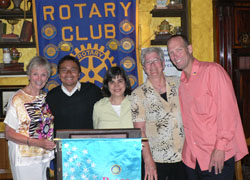Francisco Houses, by Tim Stotler, Johnny Florez, Sr Mary Sean Hodges & Sr Teresa Groth

President-Elect Sandy Ferrell is shown at left with speakers Johnny Florez, Sr Teresa Groth, Sr Mary Sean Hodges, and Tim Stottler. Sandy introduced the speakers, beginning with Tim Stottler.
Tim announced that he had been in prison for 26 years, for murder, and makes no excuses for what he did. When he was released onto the street, he had just one suit of clothes, no money, no identification, no relatives (his family is in Utah), and difficult employment prospects with a prison record and no recent work references. That day, he felt fear for his limited prospects of taking care of himself outside of prison. He called Sr Teresa Groth, who put him in contact with an intermediate house with space for him. He described the difficulty of getting a job without having identification, a birth certificate or a Social Security card; to get any one of those, he needed one or both of the other 2 of them. It took him 2 frustrating months to overcome these problems so he could even apply for a job. Even then, it’s difficult to compete for even a minimal job with a criminal record and no work references. Although he developed electrician skills in prison, applying for a job in prison is nearly impossible because a job would have to be held open for him for at least 5 months while going through the process of parole approval and finally the Governor’s signature with no release date guaranteed.
Johnny Florez described growing up with a mother impaired by alcohol and drugs, having nothing to eat and starting to steal for food. Eventually he was imprisoned for burglary. While there, he met a charming woman who explained that she had been stressed with insomnia for 13 years after having caught a burglar climbing through her window at night. That incident reminded him of himself, and he felt ashamed of the harm that he had done to others. He met some Rotarian leaders who invited him into their homes after his release and gave him warmth, acceptance and a framework for reintegrating himself into society as a responsible citizen. He is grateful for the help they gave him, and is proud of his son who has entered the Marine Corps.
Sr Mary Sean Hodges is Director of Partnership for Re-Entry Program (PREP), which works with men and women in prisons to provide them with pre-release courses and references. She explained how they work with prison officials to sign up suitable prisoners who could benefit from these services as part of their rehabilitation.
Sr Teresa Groth, Director of Francisco Homes, works with “lifer” prisoners after their release on parole. Only 3-5% of them could be eligible for release due to excellence in behavior and self motivation during their imprisonment. There are 5 of these transition residences in the Los Angeles area, currently housing 55 men. Over 60 other men have had been approved for possible release and are waiting to enter, and they receive over 1000 requests every year.
Violent offenders need a different process than shorter-term prisoners, and will never get out if they don’t work hard enough on their own rehabilitation. For release, they need a promise of placement in such a home. These mostly middle-aged men need support for their personal efforts of self-improvement, provision of emotional, spiritual and medical needs and coaching for their growth toward independence. This relationship is established before their release from prison, by correspondence and prison visits, keeping records of their release processing status, and planning for necessary support resources. They live in a homelike environment and get assistance obtaining needed documents, applying for eligible economic and educational resources and receiving employment coaching. They have support groups and help each other to become ordinary citizens. Recidivism has been less than 1%, with none of them committing a violent offense. They usually stay at one of these homes for about a year and are asked to contribute what they can to its resources.
These 2 rehabilitated former prisoners and the 2 caring humanitarian Sisters presented a heartwarming story to us of the human potential of these lost and broken lives and the obstacles and opportunities involved in effective rehabilitation, a process which is invisible to most of us who would tend to shun them.